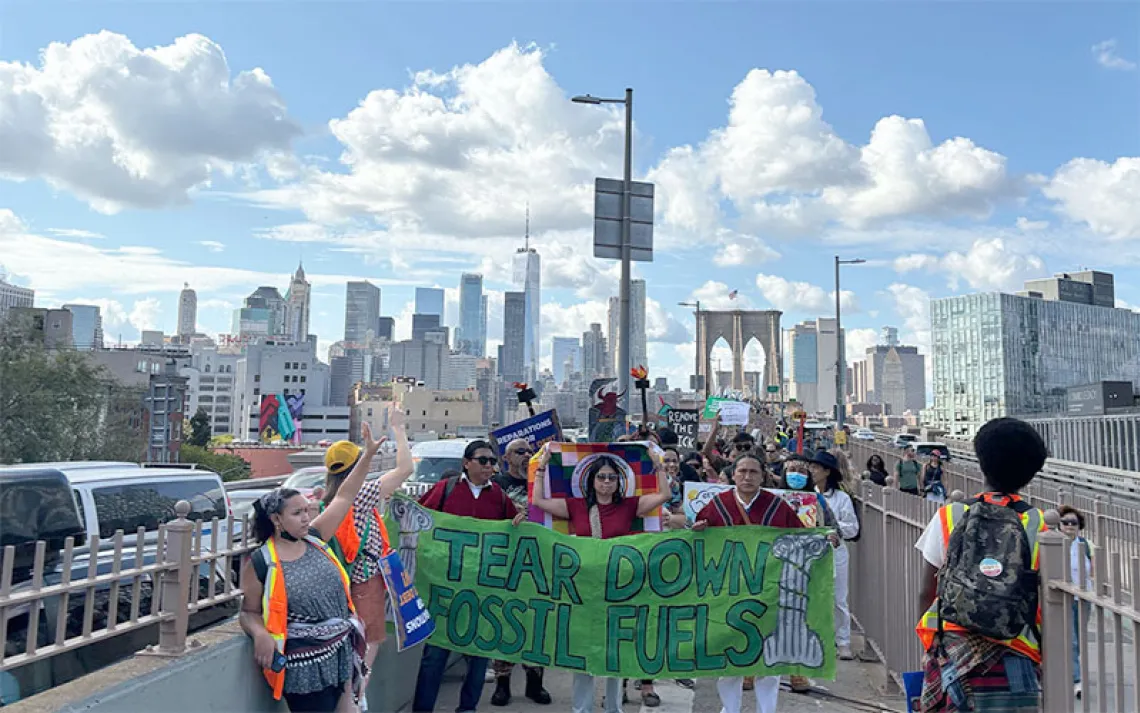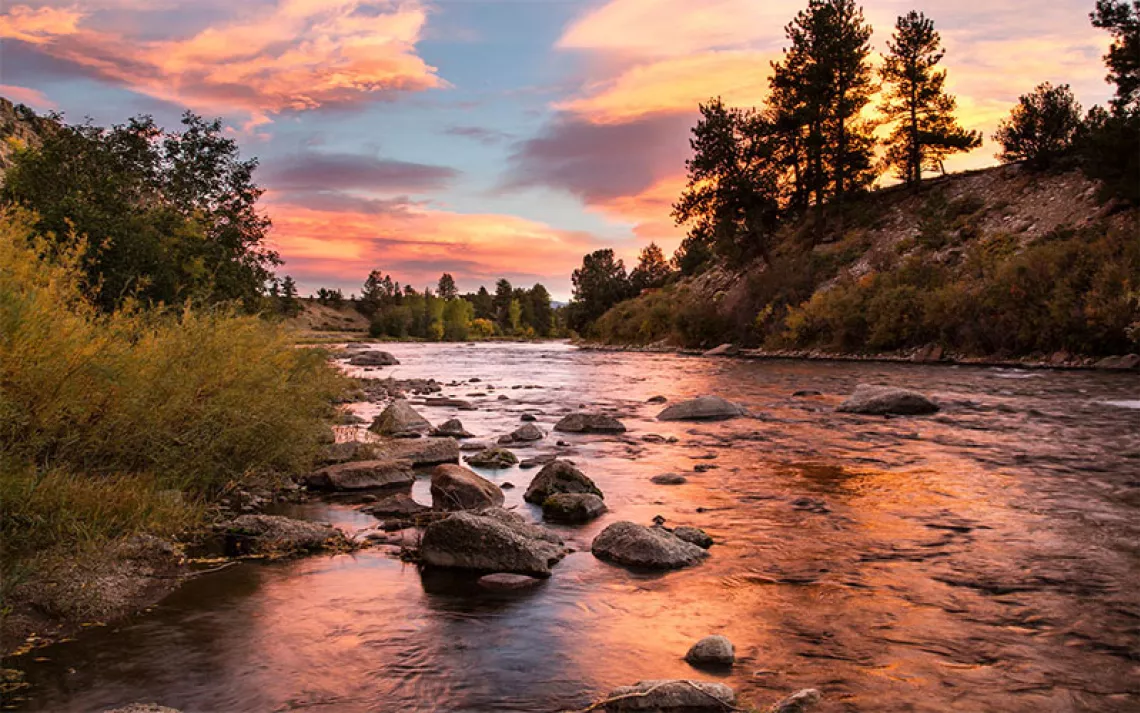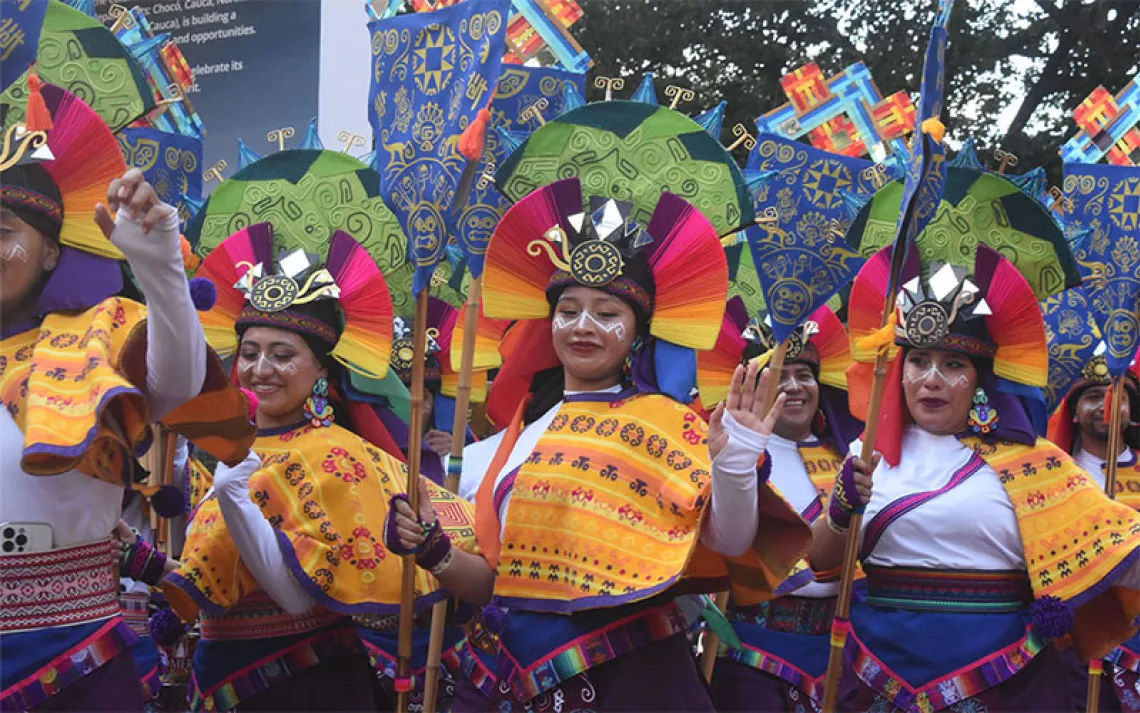Preserving Native Food Traditions
Meet the people reviving Native American culinary heritage—and restoring environmental justice

Courtesy of Elizabeth Hoover
Sean Sherman was 13 years old when he started working in restaurants. He started as a busboy, but by 27, he was an executive chef in a restaurant in Minneapolis, well on his way to a promising career.
But a few years in, Sherman—a member of the Oglala Lakota tribe—says he had an epiphany: Native American foods were sorely underrepresented across the restaurant industry. He asked, “Why? And what can we do about that?”
Now, Sherman dedicates his career to restoring Native American foodways in his work as a chef, educator, and author. In 2014, he launched a catering and food education business called The Sioux Chef, with co-owner Dana Thompson. He’s since won a James Beard Award for best American cookbook and a James Beard Leadership Award.
Beyond restoring their culinary traditions, Native Americans like Sherman are working to plant culturally important crops, revive Native American farming techniques, learn about wild food harvesting, and reconnect communities with the edible traditions of their ancestors—all in the face of generations of cultural genocide.
Indeed, by redefining Native American cuisine, chefs and educators of Native ancestry are in effect recasting the entire modern-day narrative of poverty, addiction, chronic illness, and poor diets. It's all adding up to a movement to restore cultural knowledge, advance sustainability, and encourage healthier eating.

Photo courtesy of Ken Greene
Native Americans, of course, have a long history of mistreatment by European Americans, from outright genocide to forceful relocation to broken treaties and beyond. Much of the foodways that educators and chefs are working to re-create were first disrupted during the first contact period, in the 1500s, when the initial waves of Europeans landed in North America and introduced food like beef, pork, and chicken and their byproducts.
Then came the “government-issue” period, in the 1800s, when many tribes were forced onto reservations—often far from the landscapes they’d always known. The federal government issued rations that included nutritionally deficient ingredients like flour, sugar, and lard.
“The government-issue period for Native people is historically the most traumatic and the most detrimental,” says Lois Ellen Frank, a Santa Fe–based chef and culinary anthropologist whose book, Foods of the Southwest Indian Nations, won a James Beard Award.
It’s during this time period that frybread, one of the few items that many Americans recognize as “Native American cuisine,” originated. For many Native Americans, frybread represents a painful chapter, one that forced Native communities further from diets based in vegetables, beans, and wild game, and toward unhealthy food—creating ongoing dietary issues that still impact Native communities today. “It's delicious, but can you eat donuts every day and not become obese and sick?” asks Frank, who also works in diabetes prevention and education. She points out that Native Americans and Alaska Natives have the highest rates of diabetes of all races and ethnicities in the United States, and disproportionately high rates of other chronic diseases.
Those disparities are part of what inspired Sherman, who was born on the Pine Ridge Reservation in South Dakota. His birthplace is infamous for the lowest life expectancy in the US. The per capita income for Pine Ridge Indians is just over $7,000. Rates of diabetes, infant mortality, and suicide are sky-high. “Those are some harsh realities,” Sherman says. “And it's not that people don't want to eat healthy; it's just that they don't have the access to the healthy foods at all.”
It’s in response to this crisis that chefs and activists like Frank and Sherman are mobilizing. They’re part of a modern—and more hopeful—chapter, called “new Native.”
“About 100 to 150 years later, after this very detrimental historical traumatic period for Native people, Native people are starting to come out of it,” Frank says. “We're going to reclaim our ancestral foods for health and wellness. We're going to reclaim, revitalize, and begin to understand our food sovereignty rights as Native people.”
Some restaurants, like Denver’s Tocabe and Washington, DC’s Mitsitam Native Foods Café, embrace and reclaim frybread, serving it alongside traditional foods. Others, like Albuquerque’s Pueblo Harvest Café and Seattle company Birch Basket Catering, eschew ingredients introduced by Europeans or the federal government, strictly serving “pre-contact” foods.
That’s the tack Sherman is taking with two new restaurants in the works: The Sioux Chef’s Indigenous Kitchen, planned for Minneapolis by 2021, and the Indigenous Food Lab, a combination classroom, restaurant, and training center that “reintegrates Native foods into tribal communities across North America.”

Sign up to receive Sierra News & Views
Get articles like this one sent directly to your inbox weekly.
With this action you affirm you want to receive Sierra Club communications and may vote on policy designated by the Sierra Club Board.
“We’re trying to set up a system that can hopefully be really impactful for tribes and Indigenous people to reclaim their foods, to define this amazing diversity that we have with Indigenous cultures all across the nation,” Sherman says, “and allowing the general public to be able to experience that.”
While part of the new Native movement is about bringing these foods to the masses, and putting Native American cuisine on the map, there’s another side that strengthens the connection to Native foods within individual communities. Several nonprofits and community groups are working on a grassroots level to grow culturally significant, heirloom edible plants; support Native American farmers; and revive a spectrum of food traditions.
Seed saving is an important part of the community-level effort. Activists like Rowen White, coordinator of the Indigenous Seedkeepers Network, a program of the Native American Food Sovereignty Alliance, are leading the charge to protect and resurrect Indigenous, heirloom seeds facing endangerment. White works to reconnect communities with these culturally relevant crops—which are a key part of sustainable agriculture, biodiversity, and healthy eating—through mentorship and training as well as safeguarding seeds.

Photo courtesy of Elizabeth Hoover
Often, following the forced relocation of tribes onto reservations in regions far from their native homes, plants may have struggled to survive or been left behind altogether. But White says that in some cases, “far-sighted elders kept little caches of these seeds going, and alive.” Others are turning up in seed banks, like the Seed Savers Exchange in Iowa, with which Seedkeepers Network is partnering to help bring seeds back to their origin communities.
Many are tied to tribal traditions, White says. “A lot of these varieties and a lot of these food crops relate directly back to cultural pieces, like creating stories and cosmologies. Many of them are even the bedrock of cultural identity for a lot of communities. Food and the way we nourish ourselves is the wellspring of culture.”
Ultimately, Frank sees implications for everyone, not just Native communities. She says the new Native stage calls on people of all races to participate. “All nations, all colors, all ethnicities have to work together on this idea of sustainability and wellness and health and food sovereignty,” she says. “That’s when we make a difference.”
After all, Native American food enterprises—say, a wild rice harvest in Minnesota—require a broad base of customers. Cultivation of these varieties calls for clean water, air, and soil, as well as the historical knowledge of how to grow and cook them. It’s a system that intrinsically weaves together environmental justice and cultural preservation—and involves an entire nation.
“I'm a firm believer that the more people we can educate, the better it is for all of us to live together on this one planet,” Frank says. “It's not like we have a duplicate.”
 The Magazine of The Sierra Club
The Magazine of The Sierra Club



